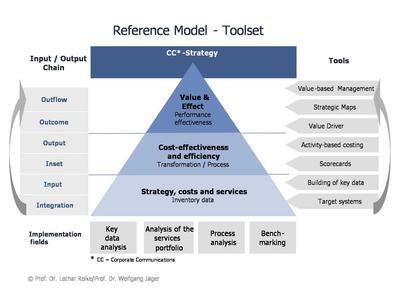Putting it into practice
Communications management is recognized in many organizations as a key source of competitive advantages. Accordingly, the relevant methods are being implemented by international corporations in Germany (e.g. Daimler, Henkel, HypoVereinsbank, Siemens, MünchnerRück), innovative medium-sized enterprises (e.g. Festo) and large companies (see case studies).
Launch processes require clear goals and plenty of patience
The development of a high-performance communication controlling system takes months to years. The process always culminates in organization-specific solutions, due to the close interrelation with the organization's particular strategy. The requirements, organization form and procedures / implementation levels differ from case to case. Standard solutions offered by a number of service providers and agencies will therefore be useful only in selected areas, for example for the generation of benchmarkable indicators.
An overall review and reference models are helpful
Before starting projects, it makes sense to have a long-term development strategy in mind and share expertise and experience on the basis of seminars, PR community meetings, coaching from consultants, and input from researchers with practical experience. Other suitable sources are scientific reference models showing the overall benefit of individual approaches. The Jäger/Rolke model is an example (2007).
Strategic benefit and monetary effects
Communication controlling may seem like a lot of work at first, but the mid-term benefits are numerous. Experience shows that most organizations have a plethora of process descriptions and indicators which they have failed to systematize and aggregate. Systematic communication controlling does away with unnecessary generation of data (e.g. media response analyses and surveys whose results are not used to improve PR) and utilizes hitherto neglected information (e.g. throughput times and process costs in the generation of employee magazines) for control purposes. Other major effects are higher job satisfaction among managers and staff because of clearer targets and processes.
Finally, professional communication controlling is an essential requirement in ensuring that public relations, customer and employee communications are duly and lastingly recognized as value drivers that merit long-term investment.


